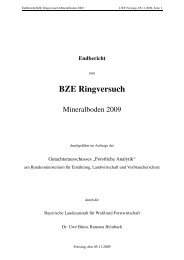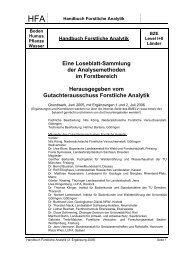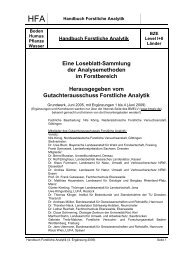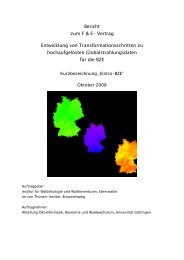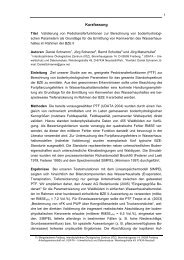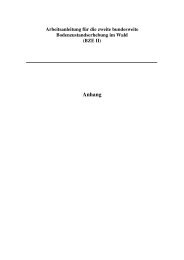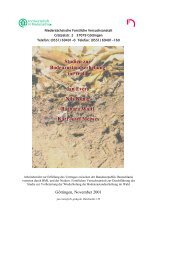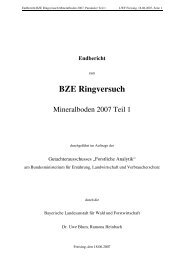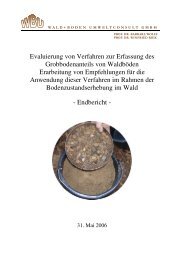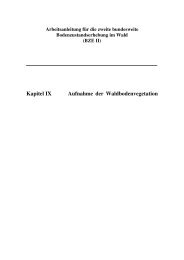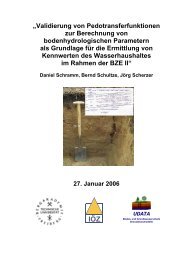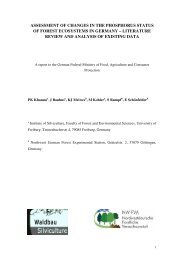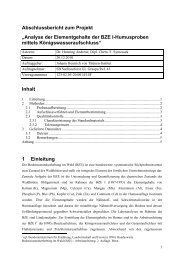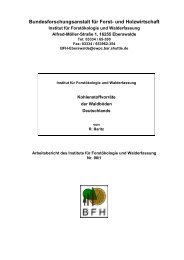assessment of changes in the phosphorus status of forest ...
assessment of changes in the phosphorus status of forest ...
assessment of changes in the phosphorus status of forest ...
Create successful ePaper yourself
Turn your PDF publications into a flip-book with our unique Google optimized e-Paper software.
High N <strong>in</strong>puts and uptake by plants may cause an imbalance <strong>of</strong> N to P ratios,<br />
affect<strong>in</strong>g plant vitality. The review provides examples for <strong>the</strong> different possible<br />
processes described here. To what extent <strong>the</strong> different mechanisms captured by<br />
<strong>the</strong>se hypo<strong>the</strong>ses are responsible for <strong>the</strong> current situation for different sites and<br />
tree species rema<strong>in</strong>s unknown.<br />
6. To analyse whe<strong>the</strong>r <strong>the</strong> variation <strong>in</strong> foliar P concentrations, soil P content, or<br />
<strong>forest</strong> floor P content may be expla<strong>in</strong>ed by <strong>the</strong> large set <strong>of</strong> <strong>in</strong>dependent parameters<br />
determ<strong>in</strong>ed <strong>in</strong> <strong>the</strong> nationwide <strong>forest</strong> soil survey, a regression tree approach was<br />
used. This data m<strong>in</strong><strong>in</strong>g approach is <strong>of</strong>ten used to generate hypo<strong>the</strong>ses from large<br />
data sets with a multitude <strong>of</strong> <strong>in</strong>dependent variables. The explorative analysis <strong>of</strong><br />
<strong>the</strong> nationwide <strong>in</strong>ventory (BZE1) data set did not provide an explanation for <strong>the</strong><br />
variation <strong>in</strong> foliar P levels. The absence <strong>of</strong> any pattern <strong>in</strong> relation to soil P was<br />
assigned to <strong>the</strong> lack <strong>of</strong> sensitive methods to determ<strong>in</strong>e long term <strong>changes</strong> <strong>in</strong> plantavailable<br />
P content <strong>of</strong> <strong>forest</strong> soils.<br />
7. The exploratory analysis <strong>of</strong> <strong>the</strong> data set <strong>in</strong>dicated that P content <strong>in</strong> <strong>forest</strong> floors<br />
was more closely related to <strong>the</strong>ir N content than to <strong>the</strong> C content, which suggests<br />
that P accumulation <strong>in</strong> <strong>the</strong> <strong>forest</strong> floor may not be a simple function <strong>of</strong> organic<br />
matter accumulation, but may be related to <strong>the</strong> accumulation <strong>of</strong> organic matter<br />
with lower C/N ratios, such as <strong>in</strong> OH layers.<br />
8. Analysis <strong>of</strong> total P <strong>in</strong> soils (as was done <strong>in</strong> <strong>the</strong> samples from <strong>the</strong> BZE I ) does not<br />
relate to <strong>the</strong> amount <strong>of</strong> plant available P <strong>in</strong> soils. Total P occurs <strong>in</strong> many organic<br />
and <strong>in</strong>organic forms <strong>in</strong> <strong>forest</strong> soils. Labile and m<strong>in</strong>eralisable fractions can be<br />
described us<strong>in</strong>g chemical extraction procedures but <strong>the</strong>ir availability <strong>in</strong> <strong>forest</strong> soils<br />
is not appropriately def<strong>in</strong>ed. Moreover, chemical extraction procedures are highly<br />
resource <strong>in</strong>tensive and cannot be employed directly to national survey samples.<br />
Given appropriate pedo-transfer functions which may <strong>in</strong>volve analysis <strong>of</strong> <strong>forest</strong><br />
soils for total P and o<strong>the</strong>r easy to measure parameters, it may be possible to assess<br />
<strong>the</strong> amount <strong>of</strong> different fractions <strong>of</strong> P <strong>in</strong> soils. However, <strong>the</strong> pedo-transfer<br />
functions developed so far are based on a limited set <strong>of</strong> samples from <strong>forest</strong> sites<br />
and <strong>the</strong>y appear to be site and bedrock specific. Presently available pedo-transfer<br />
functions cannot be used to determ<strong>in</strong>e P fractions <strong>in</strong> a wide range <strong>of</strong> samples<br />
collected on a large grid based <strong>in</strong>ventory. Due to high variation <strong>in</strong> estimat<strong>in</strong>g <strong>the</strong><br />
pedo-transfer functions, <strong>the</strong> small <strong>changes</strong> expected <strong>in</strong> <strong>the</strong> estimated amount <strong>of</strong><br />
labile P fractions may not be detectable. Therefore <strong>the</strong> use <strong>of</strong> pedo-transfer<br />
functions to determ<strong>in</strong>e <strong>the</strong> amount <strong>of</strong> P fractions <strong>in</strong> <strong>forest</strong> soils is unlikely to be a<br />
useful <strong>assessment</strong> technique.<br />
7



